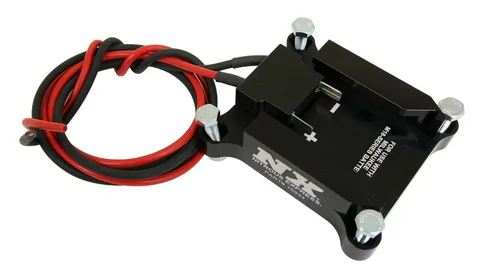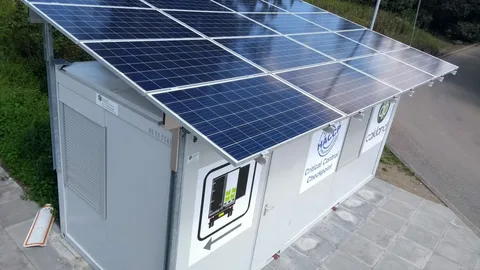In today’s world, energy independence and sustainability are becoming increasingly important. The rise of renewable energy sources like solar power has opened up a new realm of possibilities for individuals and communities to generate their electricity. At the heart of this movement is the Stand Alone battery. These powerful and versatile energy storage systems allow for the harnessing and utilization of solar energy even when the sun isn’t shining. In this blog post, we will explore the benefits and capabilities of stand-alone batteries and how they are revolutionizing the way we think about energy consumption and production.
The Basics of a Stand-Alone Battery
A stand-alone battery, a fundamental component of off-grid energy systems, operates independently of the centralized power grid, providing self-sustaining energy solutions. At its core, the stand-alone battery is designed to store excess energy generated from renewable sources, such as solar panels or wind turbines. This stored energy serves as a reliable backup, ensuring a continuous power supply even in the absence of grid connectivity. The basics of a stand-alone battery include its capacity to efficiently charge and discharge, allowing for optimal energy management.
These batteries are equipped with advanced technologies to store electricity during periods of low demand and release it when needed, enhancing overall energy utilization. Understanding the basics of a stand-alone battery involves recognizing its vital role in off-grid applications, where it acts as a primary source of power. As a sustainable and resilient solution, stand-alone batteries contribute to reducing reliance on traditional energy sources, fostering a more environmentally friendly and independent approach to energy consumption.
Understanding Stand Alone Battery Systems
Understanding stand-alone battery systems is crucial for harnessing independent and efficient energy solutions. Stand-alone battery systems, often referred to as off-grid energy storage, operate autonomously, detached from the centralized power grid. These systems store excess energy generated from renewable sources, such as solar panels or wind turbines, for later use, providing a reliable and sustainable power source.
Stand-alone battery systems play a pivotal role in ensuring uninterrupted power supply, especially in remote locations or during grid outages. Their ability to store energy during periods of low demand and release it when needed contributes to optimized energy management. In addition, Stand Alone battery systems enhance the integration of renewable energy by acting as a buffer, addressing fluctuations in energy production.
Moreover, understanding the technical components and configuration of stand-alone battery systems is essential for effective utilization. Users must grasp the principles of charging, discharging, and maintenance to maximize the lifespan and efficiency of stand-alone battery systems. With this understanding, individuals and businesses can unlock the full potential of stand-alone battery systems, embracing sustainable and resilient energy solutions for a more reliable and environmentally friendly future.
Maximizing Output: Choosing the Right Stand-Alone Battery
Maximizing output in stand-alone battery systems hinges on selecting the right battery to meet specific energy needs. The first consideration is capacity; a larger capacity ensures more energy storage, accommodating higher demand or longer periods without energy input. It’s crucial to assess the discharge rate – how quickly the battery can release stored energy – to ensure it aligns with the intended applications.
Choosing a stand-alone battery with advanced battery management systems (BMS) is essential. BMS monitors and regulates the battery’s performance, optimizing efficiency, and prolonging its lifespan. Lithium-ion stand-alone batteries often excel in this regard, offering high energy density, longer cycle life, and quicker charging times compared to traditional lead-acid batteries.
Compatibility with renewable energy sources, such as solar or wind, is another critical factor. The right stand-alone battery seamlessly integrates with these sources, facilitating efficient energy capture and storage. By understanding these factors and tailoring the choice to specific requirements, individuals and businesses can make informed decisions, maximizing the output of their stand-alone battery systems for reliable and sustainable energy solutions.
Stand Alone Solar Batteries: Harnessing the Power of the Sun
Stand-alone solar batteries represent a cutting-edge solution for harnessing the power of the sun and transforming it into reliable, sustainable energy. These stand-alone solar batteries serve as integral components in off-grid and residential settings, offering an independent and eco-friendly power source. By capturing and storing solar energy efficiently, stand-alone solar batteries ensure a continuous and reliable power supply, even during periods without sunlight.
In off-grid applications, stand-alone solar batteries empower users to break free from traditional energy constraints, providing autonomy in areas where conventional power sources are unavailable. Residential users benefit from the versatility of Stand Alone solar batteries, maximizing their self-consumption of solar energy and enhancing overall energy resilience. The design of stand-alone solar batteries prioritizes efficiency, enabling seamless integration with solar systems.
This integration enhances the overall performance of solar energy setups, optimizing the use of renewable resources. Stand-alone solar batteries play a pivotal role in advancing environmental sustainability by reducing dependence on conventional power grids and fossil fuels. As the world embraces cleaner energy alternatives, stand-alone solar batteries emerge as a cornerstone for a greener and more sustainable future.
Optimizing Efficiency with Battery Management Systems
Battery Management Systems (BMS) are integral to the operational efficiency of stand-alone batteries. Acting as the brain of the battery, the BMS is responsible for monitoring the battery’s status and optimizing its performance. A BMS helps maintain optimal charge levels, protecting the battery from overcharging and excessive discharging that could cause damage.
This active management of battery functions not only bolsters efficiency but also aids in extending the battery’s operational lifespan. Therefore, a BMS not only contributes to maintaining the battery’s health but also plays a significant role in overall energy management. It’s a vital tool in the arsenal of stand-alone power system batteries, contributing to enhanced system longevity and dependability.
Insights into a Stand Alone Solar Battery System
Embarking on the renewable energy journey unveils the transformative potential of a stand-alone solar battery system. At its core, a stand-alone solar battery system integrates seamlessly with solar panels, capturing and storing excess energy generated during sun-drenched periods. This energy reservoir, housed within the stand-alone solar battery system, becomes a crucial asset during cloudy days or nighttime, ensuring a continuous and reliable power supply.
The insights gained from deploying a Stand Alone solar battery system are profound. It empowers users with energy independence, liberating them from grid dependencies and offering a sustainable alternative. The system not only harnesses clean energy but also enhances efficiency by intelligently managing power consumption. This dual functionality of the stand-alone solar battery system maximizes self-sufficiency.
The economic benefits are evident. By reducing reliance on traditional utility grids, users can witness substantial savings on their electricity bills over time. The stand-alone solar battery system becomes a wise investment, paying dividends through long-term cost-effectiveness and resilience.
Unlocking Autonomy: Benefits of Stand-Alone Batteries
Unlocking autonomy with stand-alone batteries revolutionizes the way we harness and manage energy. These independent power storage units offer a myriad of benefits that contribute to a more sustainable and resilient energy ecosystem. Stand-alone batteries provide a sense of energy independence by allowing users to generate, store, and utilize power on-site.
This autonomy is particularly advantageous during grid outages, ensuring a continuous and reliable power supply for homes, businesses, and critical infrastructure. These batteries play a crucial role in maximizing the potential of renewable energy sources, such as solar and wind. By storing excess energy generated during peak production times, stand-alone batteries enable users to tap into clean energy even when the sun isn’t shining or the wind isn’t blowing.
The flexibility of stand-alone batteries extends to load management, allowing users to optimize energy consumption during periods of lower electricity costs. This not only reduces utility bills but also supports overall grid efficiency. In addition to economic benefits, the environmental impact of stand-alone batteries is noteworthy. By promoting the use of stored renewable energy, they contribute to the reduction of greenhouse gas emissions and foster a more sustainable approach to power consumption.
 The Role of Stand Alone Power System Batteries in Energy Independence
The Role of Stand Alone Power System Batteries in Energy Independence
Stand-alone power system batteries play a pivotal role in achieving energy independence by providing decentralized and self-sufficient energy solutions. These stand-alone power system batteries enable users to generate, store, and utilize electricity autonomously, reducing dependence on traditional grid infrastructure. The versatility of Stand Alone power system batteries allows them to seamlessly integrate with renewable energy sources like solar or wind, capturing and storing excess energy for later use.
This not only enhances the reliability of the power supply but also facilitates the utilization of clean and sustainable energy. In rural or off-grid areas, stand-alone power system batteries become the backbone of energy infrastructure, ensuring a continuous and reliable power source without the need for connection to centralized grids.
This promotes energy self-sufficiency and resilience in the face of external disruptions, contributing significantly to the concept of energy independence. Moreover, the widespread adoption of stand-alone power system batteries fosters a shift towards environmentally friendly practices, as they facilitate the utilization of green energy and minimize reliance on fossil fuels.
FAQ’s
What is a stand-alone battery and how does it work?
A stand-alone battery is a self-contained energy storage unit that operates independently of the electrical grid. It stores energy when available and releases it as needed.
How can a stand-alone battery benefit residential users?
Stand-alone batteries empower residential users by providing backup power during outages, maximizing self-consumption of solar energy, and offering cost savings through load shifting during off-peak hours.
Are stand-alone batteries compatible with solar energy systems?
Yes, stand-alone batteries seamlessly integrate with solar systems, storing excess solar-generated power for later use. This ensures a reliable and continuous energy supply, even when the sun isn’t shining.
What is the lifespan of a Stand Alone battery?
The lifespan of a Stand Alone battery varies based on factors such as technology, usage patterns, and maintenance. Generally, they can last 10-15 years or more, providing long-term reliability.
Can stand-alone batteries be used for off-grid applications?
Absolutely. Stand-alone batteries are ideal for off-grid scenarios, offering a reliable and sustainable power source. They can be the backbone of independent energy systems, providing electricity in remote locations.
How does a stand-alone battery contribute to environmental sustainability?
Stand-alone batteries support environmental sustainability by promoting the use of renewable energy sources. They enable efficient energy storage, reducing reliance on fossil fuels and lowering carbon footprints for a cleaner, greener future.
Conclusion
In conclusion, stand-alone batteries represent a step forward in our quest for energy autonomy and sustainability. They offer a dependable and efficient solution for harnessing renewable power, reducing reliance on traditional grids, and empowering individuals and communities. Regardless of where you live or what your energy needs are, a stand-alone battery system can provide a practical, cost-effective, and eco-friendly energy solution. As we continue to seek ways to make our lives more sustainable, the adoption and proper use of stand-alone batteries will undeniably play a significant role in this endeavour.
| Other Good Articles to Read |
| Niche Blogs Connect |
| Blogs 97 |
| Blog Stitution |
| Blogs Cotch Rouge |
| Blog Signatr |
| Blog Sintonias |
| Blog Zilla |
| Consumer Forums |
| Finance Forums |
| G Blogs |
| Too Blog |
| Related Business Listings |
| Contact Directory |
| Local Business Profiles |



